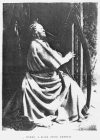
|

Patrick Byrne
(RBA 1904)
There were still a few harpers in the early 19th century who played on brass wire-strung harps, and who had been taught by teachers who themselves had been taught in a succession from the medieval harpers. Attempts were made to continue this line by setting up "societies"; poor blind boys were taught by Arthur O’Neill and Patrick Quin1. One or two became good harpers: Valentine Rennie2 became master of the Belfast harp school, while Patrick Byrne3 had a successful career touring Ireland and Scotland, playing before royalty and appearing in early photographs. However the societies themselves did not last and these individual harpers - oddities out of their time, did not manage to train successors. The last living appears to have been Patrick Murney, who explained stringing to James Laverty in 18824. Robert Bruce Armstrong was excited to find a category for wire-strung Irish harp in the first Feis Ceoil in 1897, and booked a front row seat so as to be able to take notes on technique, but there were no competitors5.
One reason why the Gaelic harp declined and disappeared during the 19th Century may be that its place as the "Irish harp" was usurped by a newly invented harp. John Egan was a Dublin harpmaker; his main business was pedal harps. He was comissioned by the harp societies mentioned above to build them harps with wire strings6, which seem to have used spare pedal harp bodies7. Between 1812-1819 he also developed a completely new kind of harp, being a smaller version of the pedal harp, using gut strings, finger ditals on the forepillar to operate the semitone mechanisms, and with a curving romantic profile8. Egan describes this as the "New improved portable Irish harp, invented by John Egan, pedal harp maker, Dublin"9. It is more commonly known as the Egan Royal Portable.
Egan's new Portable Irish harp was marketed primarily to aristocratic ladies - the "strings, tuning, fingering etc. are exactly the same as the pedal harp" according to a contemporary advert10. These instruments with their gut strings and semitone mechanisms, and curving shape and diminutive size, came to be seen as the archetypal Irish harp.

Glen harp
© K Sanger

Amy Murray
© K Sanger

G. Haarnack
© Moira
Bonnington
Egan's portable harps fell out of fashion in the mid 19th century, but there was another harp revival in the last decade or so of the century. London makers such as Morley started producing simpler imitations of the Egan designs for the Irish market. In Scotland in 1892, the president of the Mod, Lord Archibald Campbell, was initially keen that Gaelic singing should be accompanied by the harp, and commissioned wire-strung copies of the Queen Mary harp from the Edinburgh instrument maker Glen. However by 1896 these had been replaced with harps that while retaining the medieval look, were completely redesigned by the London makers Haarnack, to have a pedal-harp style soundbox, gut strings and semitone mechanisms.11
So in the space of 100 years, a harp tradition stretching back a thousand or more years had become extinct in both Scotland and Ireland, and a completely new harp tradition had evolved in those areas, based on the European classical harp. Beyond the playing of certain melodies, there was no musical or technical connection between the two traditions; the modern "celtic harp" with its pedal-harp style soundbox, gut or nylon strings and semitone levers is a direct descendent of Egan's invention. The most interesting thing is that the terms such as "Irish harp" and "clarsach", its national symbolism, its romantic and mythological associations, in fact all of the non-musical and non-technical baggage that the harp has always carried along with it12, was transferred from the former to the latter with almost no interruption.